Samsung SNB-7000 User Manual

NETWORK CAMERA
User Manual
SNB-7000

Network Camera
User Manual
Copyright
©2011 Samsung Techwin Co., Ltd. All rights reserved.
Trademark







 is the registered logo of Samsung Techwin Co., Ltd. The name of this product is the registered trademark of Samsung Techwin Co., Ltd.
is the registered logo of Samsung Techwin Co., Ltd. The name of this product is the registered trademark of Samsung Techwin Co., Ltd.
Other trademarks mentioned in this manual are the registered trademark of their respective company.
Restriction
Samsung Techwin Co., Ltd shall reserve the copyright of this document. Under no circumstances, this document shall be reproduced, distributed or changed, partially or wholly, without formal authorization of Samsung Techwin.
Disclaimer
Samsung Techwin makes the best to verify the integrity and correctness of the contents in this document, but no formal guarantee shall be provided. Use of this document and the subsequent results shall be entirely on the user’s own responsibility. Samsung Techwin reserves the right to change the contents of this document without prior notice.
Warranty
If the product does not operate properly in normal conditions, please let us know. Samsung Techwin will resolve the problem for free of charge. The warranty period is 3 years. However, the followings are excluded:
•If the system behaves abnormally because you run a program irrelevant to the system operation.
•Deteriorated performance or natural worn-out in process of time

overview
IMPORTANT SAFETY INSTRUCTIONS
1. |
Read these instructions. |
|
|
2. |
Keep these instructions. |
|
|
3. |
Heed all warnings. |
● |
|
OVERVIEW |
|
||
4. |
Follow all instructions. |
|
|
|
|
||
5. |
Do not use this apparatus near water. |
|
|
6. |
Clean only with dry cloth. |
|
|
7. |
Do not block any ventilation openings, Install in accordance with the manufacturer’s |
|
|
8. |
instructions. |
|
|
Do not install near any heat sources such as radiators, heat registers, stoves, or other |
|
|
|
9. |
apparatus (including amplifiers) that produce heat. |
|
|
Do not defeat the safety purpose of the polarized or grounding-type plug. A polarized |
|
|
|
|
plug has two blades with one wider than the other. A grounding type plug has two |
|
|
|
blades and a third grounding prong. The wide blade or the third prong are provided for |
|
|
|
your safety. If the provided plug does not fit into your outlet, consult an electrician for |
|
|
|
|
|
|
|
replacement of the obsolete outlet. |
|
|
10. Protect the power cord from being walked on or pinched particularly at plugs, convenience receptacles, and the point where they exit from the apparatus.
11. Only use attachments/ accessories specified by the manufacturer.
12. Use only with the cart, stand, tripod, bracket, or table specified by the manufacturer, or sold with the apparatus. When a cart is used, use caution when moving the cart/apparatus combination to avoid injury from tip-over.
13. Unplug this apparatus during lighting storms or when unused for long periods of time.
14. Refer all servicing to qualified service personnel. Servicing is required when the apparatus has been damaged in any way, such as power-supply cord or plug is damaged, liquid has been spilled or objects have fallen into the apparatus, the apparatus has been exposed to rain or moisture, does not operate normally, or has been dropped.
English _3

overview
WARNING
TO REDUCE THE RISK OF FIRE OR ELECTRIC SHOCK, DO NOT EXPOSE THIS PRODUCT TO RAIN OR MOISTURE. DO NOT INSERT ANY METALLIC OBJECT THROUGH THE VENTILATION GRILLS OR OTHER OPENNINGS ON THE EQUIPMENT.
Apparatus shall not be exposed to dripping or splashing and that no objects filled with liquids, such as vases, shall be placed on the apparatus.
CAUTION
CAUTION
RISK OF ELECTRIC SHOCK.
DO NOT OPEN
CAUTION : TO REDUCE THE RISK OF ELECTRIC SHOCK.
DO NOT REMOVE COVER (OR BACK).
NO USER SERVICEABLE PARTS INSIDE.
REFER SERVICING TO QUALIFIED SERVICE PERSONNEL.
EXPLANATION OF GRAPHICAL SYMBOLS
The lightning flash with arrowhead symbol, within an equilateral triangle, is intended to alert the user to the presence of “dangerous voltage” within the product’s enclosure that may be of sufficient magnitude to constitute a risk of electric shock to persons.
The exclamation point within an equilateral triangle is intended to alert the user to the presence of important operating
and maintenance (servicing) instructions in the literature accompanying the product.
4_ overview

Class  construction
construction
An apparatus with CLASS  construction shall be connected to a MAINS socket outlet with a protective earthing connection.
construction shall be connected to a MAINS socket outlet with a protective earthing connection.
Battery
Batteries(battery pack or batteries installed) shall not be exposed to excessive heat such as sunshine, fire or the like.
Disconnection Device
Disconnect the main plug from the apparatus, if it’s defected. And please call a repair man in your location.
When used outside of the U.S., it may be used HAR code with fittings of an approved agency is employed.
CAUTION
These servicing instructions are for use by qualified service personnel only. To reduce the risk of electric shock do not perform any servicing other than that contained in the operating instructions unless you are qualified to do so.
The BNC Out terminal of the product is provided for easier installation, and is not recommended for monitoring purposes.
If you keep the BNC cable connected, a risk of lightening may cause damage or malfunction to the product.
Please use the input power with just one camera and other devices must not be connected.
OVERVIEW ●
English _5

overview
Please read the following recommend safety precautions carefully.
Do not place this apparatus on an uneven surface.
Do not install on a surface where it is exposed to direct sunlight, near heating equipment or heavy cold area.
Do not place this apparatus near conductive material. |
Do not attempt to service this apparatus yourself. |
||
|
|
|
|
Do not place a glass of water on the product. |
Do not install near any magnetic sources. |
Do not block any ventilation openings. |
Do not place heavy items on the product. |
||
|
|
|
|
|
|
|
|
User’s Manual is a guidance book for how to use the products.
The meaning of the symbols are shown below.
y Reference : In case of providing information for helping of product’s usages
y Notice : If there’s any possibility to occur any damages for the goods and human caused by not following the instruction
ÚPlease read this manual for the safety before using of goods and keep it in the safe place.
6_ overview

This equipment has been tested and found to comply with the limits for a Class A digital device, pursuant to part 15 of the FCC Rules. These limits are designed to provide reasonable protection against harmful interference when the equipment is operated in a commercial environment.
This equipment generates, uses, and can radiate radio frequency energy and, if not installed and used in accordance with the instruction manual, may cause harmful interference to radio communications. Operation of this equipment in a
residential area is likely to cause harmful interference in which case the user will be required to correct the interference at his own expense.
Samsung Techwin cares for the environment at all product manufacturing stages, and is taking measures to provide customers with more environmentally friendly products.
The Eco mark represents Samsung Techwin’s devotion to creating environmentally friendly products, and indicates that the product satisfies the EU RoHS Directive.
Correct Disposal of This Product (Waste Electrical & Electronic Equipment)
(Applicable in the European Union and other European countries with separate collection systems)
This marking on the product, accessories or literature indicates that the product and its electronic accessories (e.g. charger, headset, USB cable) should not be disposed of with other household waste at the end of their working life. To prevent possible harm to the environment or human health from uncontrolled waste disposal, please separate these items from other types of waste and recycle them responsibly to promote the sustainable reuse of material resources.
Household users should contact either the retailer where they purchased this product, or their local government office, for details of where and how they can take these items for environmentally safe recycling.
Business users should contact their supplier and check the terms and conditions of the purchase contract. This product and its electronic accessories should not be mixed with other commercial wastes for disposal.
Correct disposal of batteries in this product
(Applicable in the European Union and other European countries with separate battery return systems.)
This marking on the battery, manual or packaging indicates that the batteries in this product should not be disposed of with other household waste at the end of their working life. Where marked, the chemical symbols Hg, Cd or Pb indicate that the battery contains mercury, cadmium or lead above the reference levels in EC Directive 2006/66. If batteries are not properly disposed of, these substances can cause harm to human health or the environment.
To protect natural resources and to promote material reuse, please separate batteries from other types of waste and recycle them through your local, free battery return system.
OVERVIEW ●
English _7

overview
CONTENTS
OVERVIEW |
3 |
Important Safety Instructions |
3 |
10 |
Product Features |
10 |
Recomended PC Specifications |
|
11 |
Recomended SD/SDHC Memory |
|
11 |
Card Specifications |
|
|
What’s Included |
|
|
12 |
At a Glance |
INSTALLATION &
CONNECTION
15
NETWORK CONNECTION AND SETUP
22
15Mounting the Lens
16Inserting/Removing an SD
Memory Card
18Memory Card Information (Not Included)
19Connecting with other Device
22Connecting the Camera Directly to Local Area Networking
23Connecting the Camera Directly to a DHCP Based DSL/Cable Modem
24Connecting the Camera Directly to a PPPoE Modem
25Connecting the Camera to a Broadband Router with the PPPoE/Cable Modem
26Buttons used in IP Installer
27Static IP Setup
30Dynamic IP Setup
31Port Range Forward (Port Mapping) Setup
33 Connecting to the Camera from a
Shared Local PC
33Connecting to the Camera from a Remote PC via the Internet
8_ overview

WEB VIEWER |
34 |
Connecting to the Camera |
35 |
Login |
|
34 |
36 |
Installing ActiveX |
37 |
Installing Silverlight Runtime |
|
39 |
Using the Live Screen |
|
|
42 |
Playback |
SETUP SCREEN |
44 |
Setup |
44 |
Audio & Video Setup |
|
44 |
55 |
Network Setup |
61 |
Event Setup |
|
67 |
System Setup |
|
APPENDIX |
72 |
Specification |
76 |
Product Overview |
|
72 |
77 |
Troubleshooting |
79 |
Open Source Announcement |
|
81 |
GPL/LGPL Software License |
OVERVIEW ●
English _9

overview
PRODUCT FEATURES
•Full HD Video Quality
•Multi-Streaming
This network camera can display videos in different resolutions and qualities simultaneously using different CODECs.
•Web Browser-based Monitoring
Using the Internet web browser to display the image in a local network environment.
•Alarm
If an event occurs, the event-related video will be transferred to the email specified by the user or saved to the SD memory, or the event signal will be sent to the Alarm Out port.
•Video Motion Detection
Detects a motion from the video before triggering an event.
•Face Detection / Smart Codec
Recognizes a face from the camera input video, or transfers a clearer image of your specified area.
•Auto Detection of Disconnected Network
Detects network disconnection before triggering an event.
•ONVIF (Spec 1.02) Compliance
This product supports ONVIF Core Spec. 1.02.
For more information, refer to www.onvif.org.
RECOMENDED PC SPECIFICATIONS
•CPU : Intel Core 2 Duo 2.4GHz or higher
•Operating System : Windows XP, VISTA, 7
Mac OS
•Resolution : 1280X1024 pixels or higher
•RAM : 2GB or higher
•Web Browser : Internet Explorer 7.0 or higher, Firefox, Chrome, Safari
Neither a beta test version unlike the version released in the company website nor the developer version will be supported.
On Firefox v3.5 or higher, displaying warning message dialog may cause an error.
If connecting to IPv6 in Windows XP, it can cause some problem. It is recommended to connect to IPv6 in Windows 7.
10_ overview

• Video Memory : 256MB or higher
JIf the driver of the video graphic adapter is not installed properly or is not the latest version, the video may not be played properly.
RECOMENDED SD/SDHC MEMORY CARD
SPECIFICATIONS
•2GB ~ 32GB
•To ensure proper recording of video data, it is recommended you use a memory card that supports at least read/write speed 10Mbps and Class 6.
WHAT’S INCLUDED
Please check if your camera and accessories are all included in the product package.
Appearance |
Item Name |
Quantity |
Description |
|
User Manual, |
2 |
|
|
Installer S/W DVD, |
|
|
|
CMS S/W DVD |
|
|
|
Quick Guide |
1 |
|
|
C Mount Adapter |
1 |
Used to install the camera lens |
|
Auto Iris Lens Connector |
||
|
|
|
|
|
Camera Holder (Mount) |
1 |
Used to install the camera holder |
|
Camera Holder (Mount) Screws |
2 |
Used to install the mount |
|
Lens Options (not included) |
|
|
|
CS/C Lens |
|
Optional lens to be inserted in a camera |
OVERVIEW ●
English _11
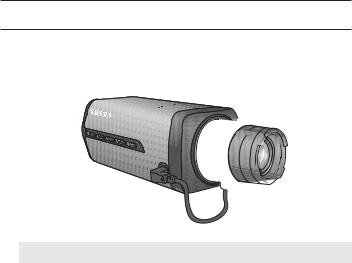
overview
AT A GLANCE
Front Side
|
Item |
Description |
Camera Holder |
Used when you mount the camera onto the bracket by fixing the camera |
|
|
(Mount) Holes |
holder (mount) adaptor with the bracket. |
b |
Auto Iris Lens |
Installed on the lens adaptor. |
(Optional) |
||
|
Auto Iris Lens |
Used to supply power and output signal to control the iris of the lens. |
c Connector |
||
MWipe out a dirty surface of the lens softly with a lens tissue or cloth to which you have applied ethanol.
12_ overview
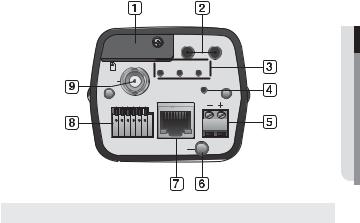
Rear Side
|
|
|
|
|
|
|
AUDIO OUT |
AUDIO IN |
|
|
SD CARD |
|
|
|
|||
|
|
|
|
|
|
SD |
SYSTEM POWER |
|
VIDEO |
|
|
|
|
|
RESET |
||
|
1 |
2 |
3 |
4 |
5 6 |
NETWORK |
|
|
|
|
|
|
|||||
1 |
: ALARM IN |
|
4 : GND ACT |
LINK |
AC 24V |
|||
2 |
: ALARM OUT |
5 : RS-485+ |
|
GND |
DC 12V |
|||
3 |
: ALARM COM 6 : RS-485- |
|
||||||
|
|
|
||||||
OVERVIEW ●
Item |
|
Description |
|
SD Memory Card |
Compartment for the SD memory card. |
||
Compartment |
|||
b Audio terminal |
AUDIO OUT |
Terminal for audio output. |
|
AUDIO IN |
Terminal for audio input. |
||
|
|||
|
|
ON : A memory card is inserted and operates normally. |
|
|
SD |
Flashing : Failed to record, insufficient space, or inserted |
|
|
abnormally. |
||
|
|
OFF : Camera is off, camera is restarting, memory card is |
|
c System, Power, |
|
not in place, or when record is off. |
|
SD Indicators |
|
ON : The camera is turned on and connected to the network |
|
|
|
properly. |
|
|
SYSTEM |
Flashing : During DDNS setup, or in case of setup failure, or |
|
|
|
in a state of unstable network connection. |
|
|
|
OFF : When the system is rebooting, or turned off. |
|
English _13

overview
Item |
|
Description |
|
System, Power, |
POWER |
ON : While the power is on |
|
c SD Indicators |
OFF : If the power is off |
||
|
Resets the camera settings to the default. Press and hold it for about 5 |
||
|
seconds to turn off the system indicator and restart the system. |
||
Reset Button |
J If you reset the camera, the network settings will be adjusted so that |
||
DHCP can be enabled. If there is no DHCP server in the network, you |
|||
|
must run the IP Installer program to change the basic network settings |
||
|
such as IP address, Subnet mask, Gateway, etc., before you can |
||
|
connect to the network. |
||
Power Port |
Used to plug the power cable. |
||
|
|
||
GND |
Used for earth-grounding. |
||
|
|
||
Network Port |
Used to connect a PoE or LAN cable. |
||
|
|
|
|
|
ALARM IN |
Used to connect the alarm input signal. |
|
|
ALARM OUT |
Used to connect the alarm output signal. |
|
I/O Port |
ALARM COM |
Common port where the alarm output signal is connected. |
|
GND |
Used for earth-grounding. |
||
|
|||
|
RS-485+ |
RS-485 Data line |
|
|
RS-485- |
RS-485 Data line |
|
Video Out Port |
Analog video output port. (for installation) |
||
|
|
|
|
JRS-485 port only supports direct connection with pan/tilt driver and external connections of the RS-485 controller is not supported.
14_ overview
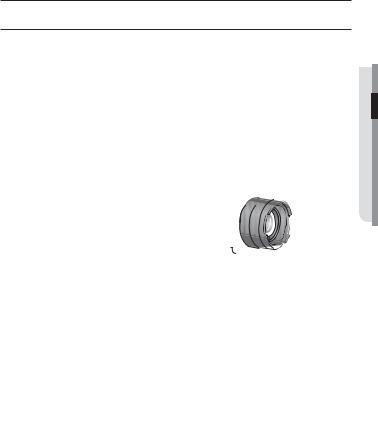
installation & connection
MOUNTING THE LENS
Disconnect the power before proceeding.
M |
The C lens and CS lens are not included in the product package. |
|
It is recommended that megapixel lens are use on this camera to optimise performance. |
Mounting the CS lens
Turn the optional CS lens clockwise to insert it.
CS Lens
Mounting the C lens
Turn the C mount adaptor clockwise to insert it and do the same with the C lens.
C Lens
CONNECTION & INSTALLATION ●
English _15

installation & connection
Connecting the Auto Iris Lens connector
Insert the lens connector into the corresponding hole of the camera.
Focusing
Turn the lens left or right to control the zoom and focus the lens so that you can view a clear, sharp object.
INSERTING/REMOVING AN SD MEMORY CARD
J Disconnect the power cable from the camera before inserting the SD memory card.
Inserting an SD Memory Card
Loosen the screw and open the cover of the SD memory card. Insert the SD card in the arrow direction.
1 2 3 4 5 6 |
|||
1 : ALARM |
IN |
4 |
: GND |
2 : ALARM |
OUT |
||
3 : ALARM |
5 |
: RS-485+ |
|
|
COM 6 |
: RS-485- |
|
JDo not insert the SD memory card while it’s upside down by force. Otherwise, it may damage the SD memory card.
16_ installation & connection

Removing an SD Memory Card
Gently press down on the exposed end of the memory card as shown in the diagram to eject the memory card from the slot.
1 2 3 4 5 |
6 |
||
1 : ALARM IN |
4 |
: GND |
|
2 : ALARM |
OUT |
||
3 : ALARM |
5 |
: RS-485+ |
|
|
COM 6 |
: RS-485- |
|
JPressing too hard on the SD memory card can cause the card to shoot out uncontrollably from the slot when released.
To remove the SD memory card, set <Record> to <Off> from <SD record> and press [Apply (  )]. (page 62)
)]. (page 62)
If you have saved data in the SD memory card, removing the SD memory card prior to setting record to OFF will cause damage to the data stored in the card.
If the SD memory is inserted, the SD LED indicator on the rear of the camera will turn on.
If there occurs a problem in the SD memory, the SD LED indicator will blink.
CONNECTION & INSTALLATION ●
English _17

installation & connection
MEMORY CARD INFORMATION (NOT INCLUDED)
What is a memory card?
The memory card is an external data storage device that has been developed to offer an entirely new way to record and share video, audio, and text data using digital devices.
Selecting a memory card that’s suitable for you
Your camera supports SD/SDHC memory cards.
You may, however, experience compatibility issues depending on the model and make of the memory card.
For your camera, we recommend you use a memory card from the following manufacturers:
SD/SDHC Memory Card : Sandisk, Transcend, Kingston
Playback performance can be affected depending on the speed of memory card, so use the high-speed memory card.
Memory Card Use
SD and SDHC memory cards feature a switch that disables writing data on to the media. Having this switch to the Lock position will prevent accidental deletion of data stored in the memory card but at the same time will also prevent you from writing data on to the media.
Memory Card Components
Contacts 








Lock Switch 
SD/SDHC
18_ installation & connection
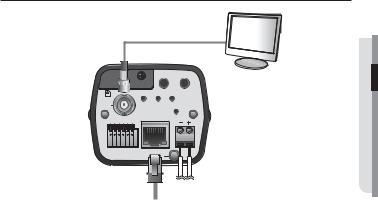
CONNECTING WITH OTHER DEVICE
|
SD CARD |
AUDIO OUT AUDIO IN |
Monitor |
|
|
|
|
|
|
|
|
SD |
SYSTEM POWER |
|
VIDEO |
|
|
RESET |
|
1 |
2 |
3 4 5 6 |
NETWORK |
|
|
|
|||
1 |
: ALARM IN |
4 : GND |
ACT |
LINK |
AC 24V |
||
2 |
: ALARM OUT |
5 |
: RS-485+ |
||||
|
GND |
DC 12V |
|||||
3 |
: ALARM COM 6 |
: RS-485- |
|
||||
Power
Ethernet
Connecting to the monitor
Connect the video out port of the camera to the video input port of the monitor.
MIn the initial installation of the camera, you can connect the camera to the monitor for checking the connection status.
You can set the video output type to either NTSC or PAL. (page 46).
Ethernet Connection
Connect the Ethernet cable to the local network or to the Internet.
Power Supply
Use the screwdriver to connect each line (+, –) of the power cable to the corresponding power port of the camera.
J |
Be careful not to reverse the polarity when you connect the power cable. |
|
You can also use a router featuring PoE (Power over Ethernet) to supply power to the camera. |
If PoE and DC 12V are both applied, this camera will get supplied with power from PoE.
Please make sure the monitor and camera are turned off when connecting them.
CONNECTION & INSTALLATION ●
English _19
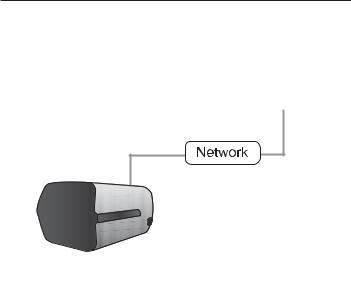
installation & connection
Connecting to Audio Input/Output
Speaker
Microphone
PC
Microphone
Network
|
1 2 3 4 5 |
6 |
|||
1 |
: ALARM |
IN |
4 |
|
: GND |
2 |
: ALARM |
OUT |
|
||
3 : ALARM |
5 |
|
: RS-485+ |
||
|
|
COM 6 |
|
: RS-485- |
|
Speaker Amp Amp Microphone
1.Connect the AUDIO IN port of the camera with the microphone directly or LINE OUT port of the amplifier that the microphone is connected to.
2.Connect the AUDIO OUT port of the camera with the LINE IN port of the speaker.
3.Check the specifications for audio input.
•Audio Codec
G.711 PCM. μ-law 64kbps 8kHz sampling
•Full duplex Audio
•Audio in
Used for mono signal line input (Max.2.4 Vpp)
•Audio out
Used for mono signal line output (Max.2.4 Vpp)
•Line out impedance
600
20_ installation & connection
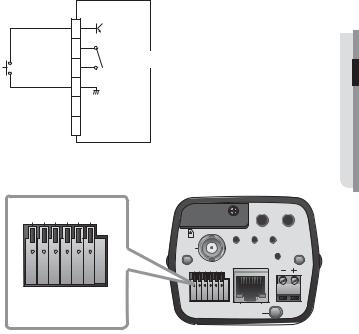
Alarm I/O Wiring Diagram
ALARM IN
ALARM OUT
ALARM COM
GND
RXTX+
RXTX-
1 |
2 |
3 |
4 |
5 |
6 |
(5mA sink)
(30VDC 2A, 125VAC 0.5A MAX)
Connecting to the I/O port box
Connect the Alarm I/O signal to the corresponding port of the rear port box.
|
1 2 3 4 5 6 |
|
|
|
|
|
|
|
|
AUDIO OUT |
AUDIO IN |
|
|
|
|
SD CARD |
|
|
|
||||||
|
|
|
|
|
|
|
|
|
|
SD |
SYSTEM POWER |
|
|
|
|
VIDEO |
|
|
|
|
|
|
RESET |
||
|
|
|
|
1 |
2 |
3 |
4 |
5 |
6 |
NETWORK |
|
|
|
|
|
|
|
|
|
||||||
1 |
: ALARM IN |
4 : GND |
|
|
|
|
|
|
|
|
|
|
2 |
: ALARM OUT |
5 : RS-485+ |
1 |
: ALARM IN |
|
4 |
: GND ACT |
LINK |
AC 24V |
|||
3 |
: ALARM COM 6 : RS-485- |
2 |
: ALARM OUT |
5 |
: RS-485+ |
|
GND |
DC 12V |
||||
3 |
: ALARM COM 6 |
: RS-485- |
|
|||||||||
•ALARM IN : Used to connect the alarm input signal.
•ALARM OUT : Used to connect the alarm output signal.
•ALARM COM : Common port where the alarm output signal is connected.
•GND : Used for earth-grounding.
•RS-485+ : Communication port for RS-485 receiver (+).
•RS-485- : Communication port for RS-485 receiver (–).
Connecting an external RS-485 device
Connect the camera with an external device using the [RS-485 +, -] ports.
You can control the pan/tilt operations of the camera via RS-485 communications.
CONNECTION & INSTALLATION ●
English _21
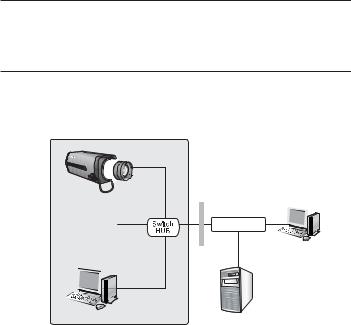
network connection and setup
You can set up the network settings according to your network configurations.
CONNECTING THE CAMERA DIRECTLY TO LOCAL AREA NETWORKING
Connecting to the camera from a local PC in the LAN
1.Launch an Internet browser on the local PC.
2.Enter the IP address of the camera in the address bar of the browser.
Camera
|
INTERNET |
|
External Remote PC |
Camera |
Firewall |
|
|
|
DDNS Server |
Local PC |
(Data Center, KOREA) |
<Local Network>
MA remote PC in an external Internet out of the LAN network may not be able to connect to the camera installed in the intranet if the port-forwarding is not properly set or a firewall is set. In this case, to resolve the problem, contact your network administrator.
By factory default, the IP address will be assigned from the DHCP server automatically. If there is no DHCP server available, the IP address will be set to 192.168.1.100.
To change the IP address, use the IP Installer.
For further details on IP Installer use, refer to “Static IP Setup”. (Page 27)
22_ network connection and setup
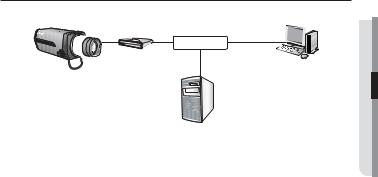
CONNECTING THE CAMERA DIRECTLY TO A DHCP BASED DSL/CABLE MODEM
DSL/Cable |
INTERNET |
|
|
Modem |
External Remote PC |
|
Camera
DDNS Server
(Data Center, KOREA)
1.Use the cross LAN cable to connect the network cable directly to your PC.
2.Run the IP Installer and change the IP address of the camera so that you can use the web browser on your desktop to connect to the Internet.
3.Use the Internet browser to connect to the camera.
4.Move to [Setup] page.
5.Move to [Network] – [DDNS] and configure the DDNS settings.
6.Move to [Network] – [Interface], and set the network type to [DHCP].
7.Connect the camera, which was removed from your PC, directly to the modem.
8.Restart the camera.
MFor registering the DDNS settings, refer to “Registering with DDNS”. (page 57)
For configuring the DDNS settings, refer to “DDNS”. (page 56)
For setting the network type, refer to “Interface”. (page 55)
SETUP AND CONNECTION NETWORK ●
English _23

network connection and setup
CONNECTING THE CAMERA DIRECTLY TO A PPPoE
MODEM
INTERNET 
PPPoE Modem
External Remote PC
Camera
DDNS Server
(Data Center, KOREA)
1.Use the cross LAN cable to connect the network cable directly to your PC.
2.Run the IP Installer and change the IP address of the camera so that you can use the web browser on your desktop to connect to the Internet.
3.Use the Internet browser to connect to the camera.
4.Move to [Setup] page.
5.Move to [Network] – [DDNS] and configure the DDNS settings.
6.Move to [Network] – [Interface], and set the network type to [PPPoE].
7.Connect the camera, which was removed from your PC, directly to the modem.
8.Restart the camera.
MFor registering the DDNS settings, refer to “Registering with DDNS”. (page 57)
For configuring the DDNS settings, refer to “DDNS”. (page 56)
For setting the network type, refer to “Interface”. (page 55)
24_ network connection and setup
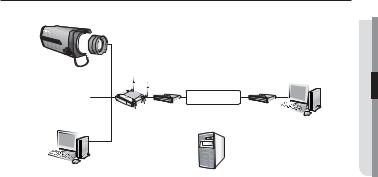
CONNECTING THE CAMERA TO A BROADBAND ROUTER WITH THE PPPoE/CABLE MODEM
This is for a small network environment such as homes, SOHO and ordinary shops.
Camera |
|
|
|
|
|
|
INTERNET |
|
Broadband |
PPPoE or |
PPPoE or |
Camera |
Cable Modem |
Cable Modem |
|
Router |
|
External Remote |
|
|
|
|
PC |
Local PC
DDNS Server
(Data Center, KOREA)
Configuring the network settings of the local PC connected to a
Broadband Router
Configuring the network settings of the local PC connected to a Broadband Router, follow the instructions below.
•Select : <Network Neighborhood> <Properties> <Local Area Connection>
<Properties> <General> <Internet Protocol (TCP/IP)> <Properties>
<Obtain an IP address automatically> or <Use the following IP address>.
•Follow the instructions below if you select <Use the following IP address>: ex1) If the address (LAN IP) of the Broadband Router is 192.168.1.1
IP address : 192.168.1.100 Subnet Mask : 255.255.255.0 Default Gateway : 192.168.1.1
ex2) If the address (LAN IP) of the Broadband Router is 192.168.0.1 IP address : 192.168.0.100
Subnet Mask : 255.255.255.0 Default Gateway : 192.168.0.1
ex3) If the address (LAN IP) of the Broadband Router is 192.168.xxx.1 IP address : 192.168.xxx.100
Subnet Mask : 255.255.255.0 Default Gateway : 192.168.xxx.1
MFor the address of the Broadband Router, refer to the product’s documentation.
Refer to the “Port Range Forward (Port Mapping) Setup” section of the Broadband Router’s documentation. (Page 31)
SETUP AND CONNECTION NETWORK ●
English _25

network connection and setup
BUTTONS USED IN IP INSTALLER
Item |
Description |
Device Name |
Model name of the connected camera. |
Click the column to sort the list by model name. |
|
|
However, search will be stopped if clicked during the search. |
b Mode |
Displays either <Static> or <Dynamic> for the current network connection |
status. |
|
c MAC(Ethernet) |
Ethernet address for the connected camera. |
Click the column to sort the list by Ethernet address. |
|
Address |
However, search will be stopped if clicked during the search. |
|
IP address. |
IP Address |
Click the column to sort the list by IP address. |
However, search will be stopped if clicked during the search. |
|
|
The factory default is “192.168.1.100”. |
Protocol |
Network setting for the camera. |
The factory default is “IPv4”. |
|
|
Cameras with the IPv6 setting will be displayed “IPv6”. |
UPnP Status |
This function is not currently implemented. |
26_ network connection and setup

Item |
Description |
URL |
DDNS URL address enabling access from the external Internet. |
However, this will be replaced with the <IP Address> of the camera if |
|
|
DDNS registration has failed. |
IPv4 |
Scans for cameras with the IPv4 setting. |
IPv6 |
Scans for cameras with the IPv6 setting. |
Search |
Scans for cameras that are currently connected to the network. |
However, this button will be grayed out if neither IPv4 nor IPv6 is checked. |
|
Auto Set |
The IP Installer automatically configures the network settings. |
Manual Set |
You should configure the network settings manually. |
m Exit |
Exits the IP Installer program. |
MFor the IP installer, use only the installer version provided in the installation DVD or use the latest one if available. You can download the latest version from the product website.
SETUP AND CONNECTION NETWORK ●
STATIC IP SETUP
Manual Network Setup
Run <IP Installer_vX.XX.exe> to display the camera search list.
At the initial startup, both [Auto Set] and [Manual Set] will be grayed out.
MFor cameras found with the IPv6 setting, these buttons will be grayed out as the cameras do not support this function.
1.Select a camera in the search list. Find the MAC (Ethernet) address labeled on the rear of the camera. Both the [Auto Set] and [Manual Set] buttons will be activated.
2.Click [Manual Set].
The Manual Setting dialog appears. The default values of <IP Address>,
<Subnet Mask>, <Gateway>, <HTTP Port> and <VNP Port> of the camera will be displayed.
English _27
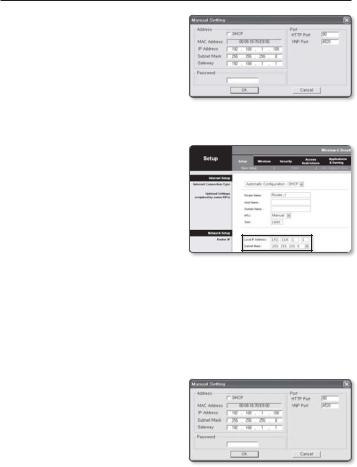
network connection and setup
3.In the <Address> pane, provide the necessary information.
•MAC (Ethernet) Address : The MAC (Ethernet) address of the applicable camera will be set automatically so you don't need to input it manually.
MYou can configure the static IP settings only if the DHCP checkbox is unchecked.
If using a Broadband Router
•IP Address : Enter an address falling in the IP range provided by the Broadband Router.
ex) 192.168.1.2~254, 192.168.0.2~254, 192.168.XXX.2~254
•Subnet Mask : The <Subnet Mask> of the Broadband Router will be the
<Subnet Mask> of the camera.
•Gateway : The <Local IP Address> of
the Broadband Router will be the <Gateway> of the camera.
MThe settings may differ depending on the connected Broadband Router model. For more information, refer to the user manual of the applicable router.
Refer to the “Port Range Forward (Port Mapping) Setup” section of the Broadband Router’s documentation. (Page 31)
If not using a Broadband Router
For setting <IP Address>, <Subnet Mask>, and <Gateway>, contact your network administrator.
4.In the <Port> pane, provide necessary information.
•HTTP Port : Used to access the camera using the Internet browser, defaulted to 80. Use the spin button to change the HTTP Port value.
•VNP Port : Used to control the video signal transfer, defaulted to 4520.
5.Enter the password.
This is the login password for the “admin” user who accesses the camera. The default password is “4321”.
28_ network connection and setup

6.Click [OK].
Manual network setup will be completed.
7.When the manual setup including IP is completed, the camera will restart.
If the Broadband Router has more than one camera connected
Configure the IP related settings and the Port related settings distinctly with each other.
|
Category |
Camera #1 |
Camera #2 |
|
IP related settings |
|
IP Address |
192.168.1.100 |
192.168.1.101 |
|
Subnet Mask |
255.255.255.0 |
255.255.255.0 |
|
|
|
Gateway |
192.168.1.1 |
192.168.1.1 |
Port related settings |
|
HTTP Port |
8080 |
8081 |
|
VNP Port |
4520 |
4521 |
|
MIf the <HTTP Port> is set other than 80, you must provide the <Port> number in the address bar of the Internet browser before you can access the camera.
ex) http://IP address : HTTP Port http://192.168.1.100:8080
SETUP AND CONNECTION NETWORK ●
Auto Network Setup
Run <IP Installer_vX.XX.exe> to display the camera search list.
At the initial startup, both [Auto Set] and [Manual Set] will be grayed out.
MFor cameras found with the IPv6 setting, these buttons will be grayed out as the cameras do not support this function.
1.Select a camera in the search list. Find the MAC (Ethernet) address labeled on the rear of the camera. Both the [Auto Set] and [Manual Set] buttons will be activated.
2.Click [Auto Set].
The Auto Setting dialog appears.
The <IP Address>, <Subnet Mask>, and <Gateway> will be set automatically.
English _29

network connection and setup
3.Enter the password.
This is the login password for the “admin” user who accesses the camera. The default password is “4321”.
4.Click [OK].
Auto network setup will be completed.
DYNAMIC IP SETUP
Dynamic IP Environment Setup
•Example of the Dynamic IP environment
-If a Broadband Router, with cameras connected, is assigned an IP address by the DHCP server
-If connecting the camera directly to modem using the DHCP protocols
-If IPs are assigned by the internal DHCP server via the LAN
Checking the Dynamic IP
1.Run the IP Installer on the user’s local machine to display cameras allocated with <Dynamic IP> addresses in the list.
2.Select a camera in the list, and click [Manual Set] to check the <Dynamic
IP> of the camera.
If you uncheck <DHCP>, you can change IP to <Static>.
30_ network connection and setup
